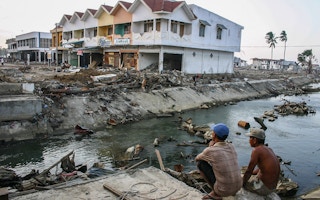The Green Climate Fund, set up to channel billions of dollars for poor nations to combat climate change, has smoothed over board divisions that had threatened to derail it, paving the way to refill its coffers this year, its leaders and observers said.
The fund, to which donor governments initially pledged more than $10 billion, said on Thursday after meeting this week its 24-member board was now in a stronger position to pursue its first replenishment, due to be completed in October.
On Monday, the Green Climate Fund (GCF) selected Yannick Glemarec, a French national who has held senior roles at UN agencies, as its new executive director.
His predecessor quit suddenly at a fractious board meeting last July, where disagreements between representatives from developed and developing nations over how to spend the fund’s resources meant no projects were approved.
This week, the board allocated $440 million for nine new projects, from boosting investment in solar power in West Africa to promoting clean cooking in Kenya and Senegal.
It also agreed to provide $122.5 million to help developing countries get ready to apply for and deploy GCF funding.
Javier Manzanares, the fund’s acting executive director, noted it was now investing $5 billion in projects to support low-carbon and climate-resilient development in 97 countries.
“With decisions to ensure better governance, new project approvals, and a reinforced readiness programme, this board meeting has left us in great shape for our first replenishment,” he said in a statement.
The fund has yet to set a target for how much it wants to raise from donors this year.
But it has had less money than expected to distribute after US President Donald Trump refused to stump up two-thirds of Washington’s former pledge of $3 billion.
Currency fluctuations also have shaved roughly $1 billion off available funds, leaving the GCF with about $2 billion left to hand out, analysts said.
Niranjali Amerasinghe, a sustainable finance researcher with the World Resources Institute, said the board, which has new co-chairs and some new members, had worked this week in South Korea with “a more collegial atmosphere”, engaging in “thoughtful and substantive discussions”.
“It is a good start to the year,” she told the Thomson Reuters Foundation after the meeting. “I hope the board will continue to work like this.”
Key governance issues were settled at the meeting, including a mechanism to address complaints, a policy to prevent money laundering and financing of terrorist activities, and another on protection from sexual exploitation, abuse and harassment.
But others were deferred, such as a procedure for voting on decisions if consensus cannot be reached.
“
With decisions to ensure better governance, new project approvals, and a reinforced readiness programme, this board meeting has left us in great shape for our first replenishment.
Javier Manzanares, acting executive director, Green Climate Fund
Amazon protection
One of the key new measures backed by the board was $96.5 million in payments to Brazil for efforts in 2014 and 2015 to cut climate-changing emissions by protecting the Amazon rainforest - the first such project approved by the GCF.
Conservationists said the money - while small compared with the overall value of the carbon stored in Brazil’s forests - was symbolically important because it sent a positive signal to the government and farmers that curbing deforestation could bring financial benefits.
Daniel Nepstad, head of the Earth Innovation Institute, which works on climate-friendly rural development, said the GCF contract was “hugely important for this perilous moment in Brazil”.
Its new right-wing president, Jair Bolsonaro, has hinted his government would hand over more forest land to agribusiness.
“In Brazil, one of the most important questions today is: will its forest conservation achievements pay? If the answer is ‘yes’ - and this contract helps provide that ‘yes’ - the chances of securing and deepening Brazil’s forest conservation legacy increase,” Nepstad said by email.
Some forest experts are worried, however, that deforestation is creeping back up in Brazil, and rewarding earlier success overlooks that reversal.
Nepstad said that when a nation cuts deforestation by more than half and keeps 80 per cent of its forest standing, as Brazil has done, “then it needs recognition and compensation”.
The measures Brazil took to safeguard its forests - such as enforcing its forest code, expanding protected areas, and a moratorium on buying soy grown on illegally cleared land - were hard to sustain without stronger economic incentives, he added.
Alexandra Pinzon, who works on financing for sustainable landscapes with environmental group Global Canopy, said payments for reducing emissions from forests could provide incentives for countries to continue with forest protection efforts.
But in Brazil, monitoring how the money is spent will be important, she said, with the system for using the cash still being designed and the government lacking the capacity to ensure it would go to prevent further deforestation.
This story was published with permission from Thomson Reuters Foundation, the charitable arm of Thomson Reuters, that covers humanitarian news, climate change, resilience, women’s rights, trafficking and property rights. Visit http://news.trust.org/climate.










